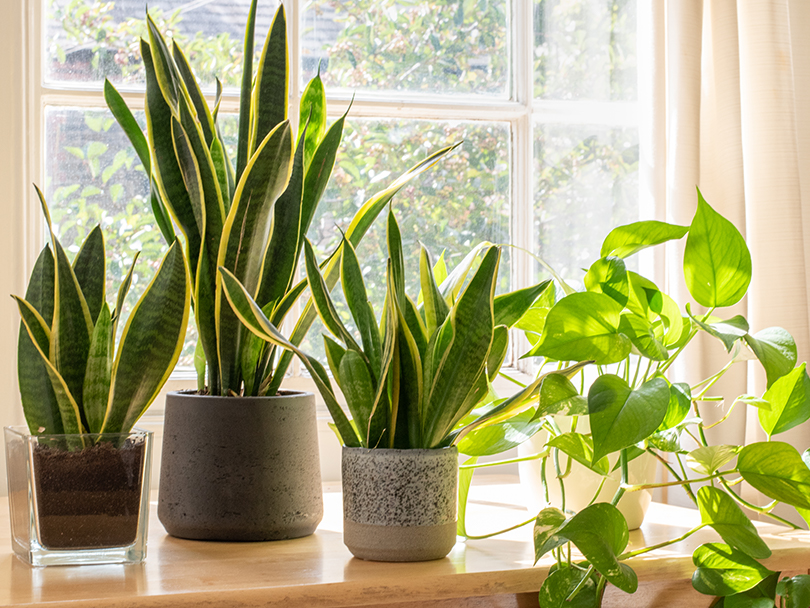By Vicki Spencer, Master Gardener
Indoor plants aren’t just an affordable way to add interest to your decor. They can also improve your home’s air quality. Although a NASA study found it would take dozens of plants working together to detoxify all the airborne toxins, dust and germs in a typical house, there is evidence we can improve our home’s air quality with a few key plants. Among the most widely recognized are spider plant, snake plant, aloe vera, English ivy, red-edged dracaena and prayer plant.
Spider plants reduce carbon monoxide and xylene, which is found in ink and rubber. They make lovely hanging plants with small “spiderettes” that dangle from long stems. You can propagate more spider plants by cutting the spiderettes near the base of their stems, trimming the stems and then placing spiderettes in a glass of water or moist soil to root.
Snake plants don’t have stems; just thick leaves that grow upright. The most common variety, Sansevieria trifasciata, has dark green foliage with silvery horizontal streaks. Other varieties have variegated leaves with yellow or cream edges. The snake plant’s vertical profile makes it perfect for tucking into a living room or bedroom corner with low light.
The smaller Sansevieria trifasciata ‘Hahnii’ forms clusters of leaves that appear similar to a bird’s nest and it looks nice on a bookshelf. Unlike most plants, snake plants are able to convert carbon dioxide into oxygen at night in addition to filtering formaldehyde, benzene, toluene and trichloroethylene out of the air.
Aloe vera has always been a must-have plant in my kitchen because of its soothing properties. If anyone gets burned while cooking, it’s always readily available. Just cut a leaf off and squeeze the liquid out. My kids always knew to use aloe for sunburns or insect bites. Last year, when hand sanitizer was nowhere to be found, my son told me to make my own with aloe and alcohol. The added benefit of aloe vera is it cleans the air of formaldehyde and benzene found in floor finishes, varnishes and detergents.
English ivy is an easy-to-grow perennial vine that is effective in detoxifying bathroom air by reducing airborne fecal particles and combating the growth of mold. It enjoys moisture and four hours of direct sunlight per day.
Red-edged dracaena (dragon tree) is often included in “get well” plant gardens from the florist. After some research, I now know why. Not only do its spiky leaves with bright red edges add interest to the arrangement, it also fights pollutants like trichloroethylene and xylene. Although slow-growing, some can reach 8 feet when given abundant sunlight.
Prayer plant is the most temperamental air purifier because it’s a tropical plant. When craving moisture, the leaves droop so low it’s a pitiful sight, but watering and misting a couple times per week keeps it perky. While cleaning the air, it may serve as a sleep aid by adding humidity in a house with dry air.
It’s not practical to keep all the plants in NASA’s experiment, but adding even a little foliage inside your home can be favorable in more ways than one.
Gardener Vicki Spencer has an eclectic background in conservation, water, natural resources and more.

